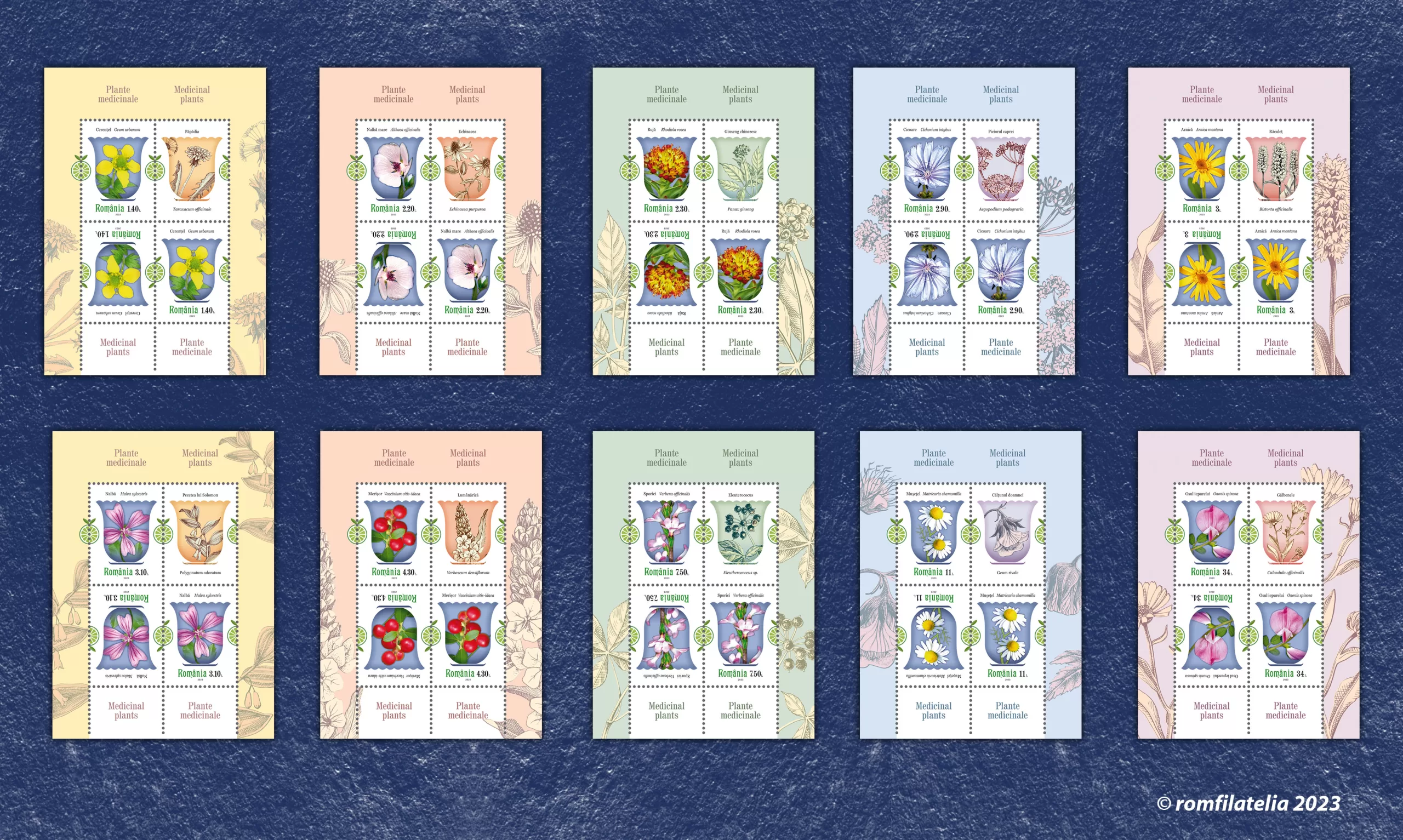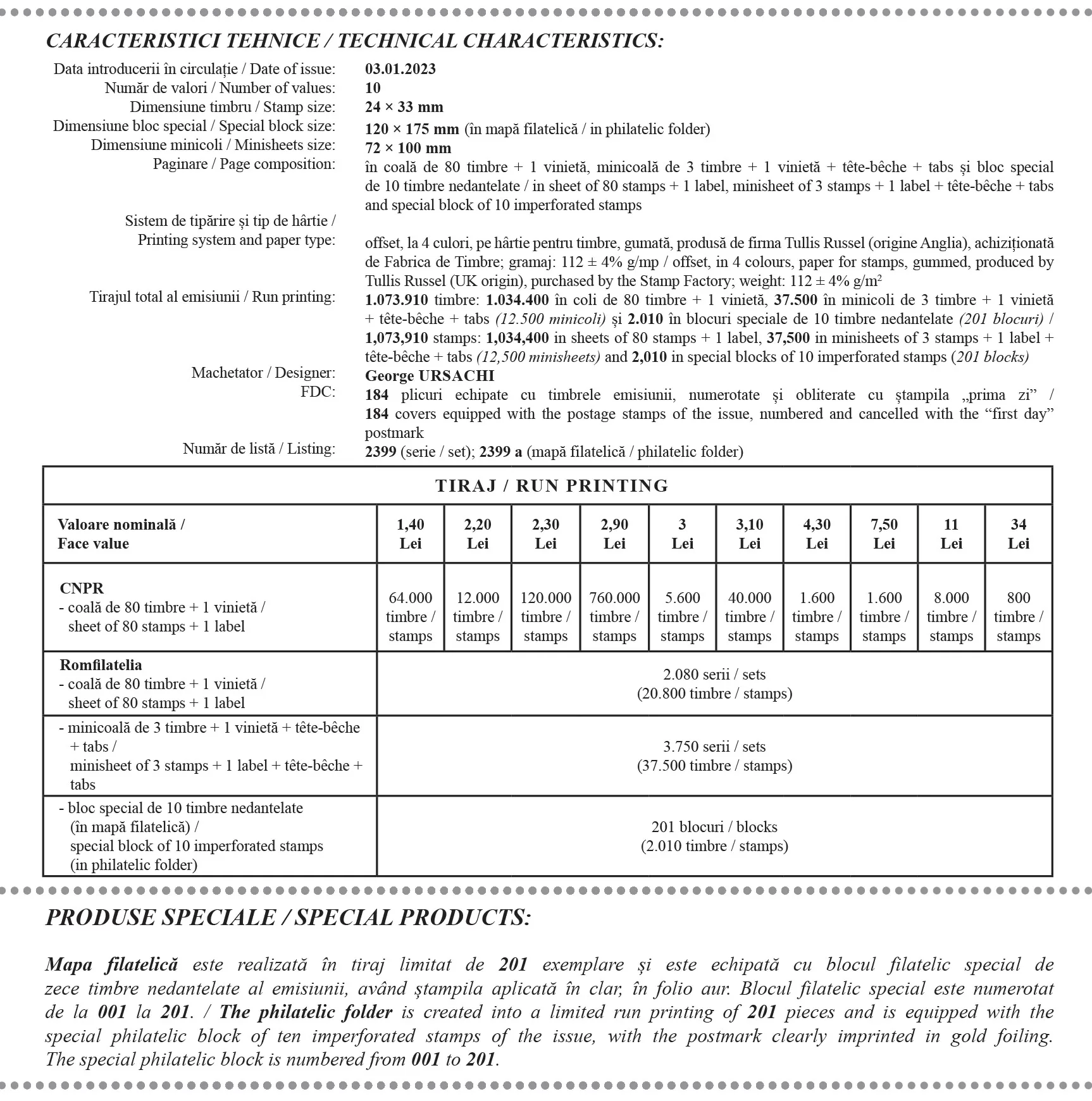 Romfilatelia provides the public and collectors, on Tuesday, January 3rd , the first issue of definitive postage stamps of the year 2023 entitled “Medicinal plants”.
Romfilatelia provides the public and collectors, on Tuesday, January 3rd , the first issue of definitive postage stamps of the year 2023 entitled “Medicinal plants”.
Promoting “Green Pharmacy”, the issue presents on the ten stamps the images of medicinal plants known for their beauty, to which are added the beneficial properties for preserving health and treating certain ailments.
Wood avens – Geum urbanum – illustrated on the stamp with the face value of Lei 1.40, is an herbaceous plant of the Rosaceae family, reaching a height of 30-40 cm. The rhizome is used both therapeutically and to season soups, sauces or beer. The active ingredients in the rhizome give it antiseptic, astringent, haemostatic and analgesic properties. It reduces and removes muscle spasms. It also acts as an antiviral, antiseptic, cicatrizing. It is used to combat diarrhoea and dysentery, to relieve pain in gastric ulcers, to soothe toothache.
Marsh mallow – Althaea officinalis – represented on the stamp with face value of Lei 2.20, belongs to the Malvaceae family. It is a biennial or perennial herbaceous plant with straight stems, up to 1 m tall, branched and covered with hairs, with large pinkish-purple flowers with purple vines, long-stalked, greenish-woody and velvety leaves due to the very thick hairs. In the spontaneous flora, it grows from the lowland to the beech floor, through ruderal places, meadows, riverside coppices, grasslands, water banks, being a water-loving species. It blooms from July to September. Native distribution includes Europe, Western Asia, Northwest Africa. Both roots and leaves contain mucilaginous substances beneficial in acute inflammations of the respiratory tract (laryngitis, tracheitis, bronchitis). It can also be used in gastritis and colitis, and in oral diseases.
Rhodiola – Rhodiola rosea – illustrated on the stamp with the face value of Lei 2.30, is a plant of the Crassulaceae family that grows in the subarctic and subalpine areas of the northern hemisphere. Also known as “Golden Root” or “Arctic Root”, it has been used for thousands of years to combat stress, reduce depression, treat fatigue, but also to increase body strength and fertility or in skin care.
Rhodiola rosea is a perennial plant and has a thick, fleshy, cylindrical rhizome with a strong rose odour. This rhizome has medicinal properties with multiple benefits on human health.
Chicory – Cichorium intybus – represented on the stamp with the face value of Lei 2.90, is a widespread, herbaceous, perennial plant belonging to the Asteraceae family. Its native area includes Europe, the west and the south-west of Asia, the north of Africa.
It has a thick root that continues with a short, lignified rhizome. The branched stem is 50-150 cm tall. The basal leaves are lanceolate, notched, the upper leaves sessile, with toothed margin. The ligulate flowers are blue, rarely white or pink.
Among the therapeutic properties of this plant are: hepatoprotective, digestive, laxative, depurative, hypoglycaemic, hypotensive, antiarrhythmic, diuretic, general tonic-aperient, eupeptic-bitter, comforting, remineralising.
Leopard’s bane – Arnica montana – depicted on the stamp witth the face value of Lei 3, plant of the Asteraceae family, is a perennial species with orange-yellow flowers similar to daisies. Stems reach up to 20 – 40 cm in height, being round and covered with glandular hairs almost below the inflorescence.The leaves and the flowers of leopard’s bane can be used to prepare poultices, decoctions or tinctures that are used externally, with beneficial effect in case of contusions, sprains, bruises.
Mallow – Malva sylvestris – represented on the stamp with the face value of Lei 3.10, is a plants that belongs to Malvaceae family. It is widespread from Europe to Central Asia and the western Himalayas, as well as Northern Africa. Malva sylvestris is a very common species in our country, easily found in fields, along paths and roads, in meadows, bushes, forest edges and even in some inhospitable places, such as fallow lands and fields.
The flowers have a corolla of five long petals up to about 3 cm long, emarginate, of a beautiful purple-pink, with purple venation. Together with the leaves, they can be used therapeutically for their emollient properties. Thus, the decoction of flowers and leaves soothes irritation of the mucous membranes, being beneficial in bronchitis, dry cough, inflammation of the throat. The decoction of mallow flowers and leaves also helps to reduce inflammation of the intestine and has a laxative effect. Externally, it can be used for skin irritations and inflammations.
Lingonberry – Vaccinium vitis-idaea – illustrated on the stamp with the face value of Lei 4.30, is an evergreen, dwarf shrub belonging to the Ericaceae family. The persistent, ovate leaves are 1-3 cm long, with slightly curled margins, dark green, glossy upper side and dull lower side with black dots. The campanulate flowers are white or pale pink, with accreted petals. The fruits are spherical berries, bright red in colour. The lingonberry is a plant originating in Europe, Asia and North America. The lingonberry
is used to treat urogenital inflammation (acute and chronic cystitis, urethritis, leukorrhea, pyelonephritis). Vitamin C in the fruit, together with antioxidant minerals, can prevent flu and the common cold.
Vervain or common verbena – Verbena officinalis – depicted on the stamp with the face value of Lei 7.50, belongs to the Verbenaceae family and is an herbaceous plant, 0.3 – 0.8 m tall. The stem is erect, tetramerous, branched. The leaves are opposite, ovate-triangular, trifoliate, especially the basal ones. he active principles in the aerial parts of the flowering plant are attributed anaesthetic, prostaglandin-enhancing, anti-inflammatory, antimigraine, galactagogue, anti-rheumatic, astringent, aperient-bitter, cicatrizing properties.
Chamomile – Matricaria chamomilla – represented on the stamp with the face value of Lei 11, belongs to the Asteraceae (Compositae) family.
It is an annual herbaceous plant with a taproot. The hairless stem is erect, 10-50 cm, more or less branched. The leaves are 2-3 times pinnately divided, with 6-10 pairs of linear hairless laciniae. The flowers are arranged on a conical receptacle, empty inside. The plant is of Eurasian origin and is common from the steppe zone to the beech floor, through meadows, vineyards, acacia plantations, fallow, ruderal places and salty lands. Chamomile is valued for its antispasmodic, anti-inflammatory, anti-allergic, cicatrizing and immune-stimulating action. It is also used to treat bloating and digestive disorders.
Spiny restharrow – Ononis spinosa – depicted on the stamp with the face value of Lei 34, is a species of the Fabaceae (Leguminosae) family, originating in Europe, Southwest Asia and Northern Africa. It is perennial, 30-80 cm tall, with erect or ascending, highly branched stem. The branches are thorny, with stiff thorns. The lower leaves are trifoliolate, the upper ones unifoliolate, on both sides with glandular hairs. The flowers are pink, single or 2, rarely 3, axillary. It blooms from spring to autumn. Spiny restharrow can be found in meadows and scrublands from the lowlands to the common oak floor. It has the following therapeutic properties, beneficial to health: detoxifying, depurative, mildly laxative, astringent, cholagogue, diuretic, fortifying, expectorant, antitussive, sudorific, mildly hypnotic, anti-rheumatic, antiseptic, urinary antiseptic, anti-inflammatory. The root is used to prepare an infusion for internal use.
Romfilatelia thanks Prof. Paulina Anastasiu Ph.D., Manager of “Dimitrie Brandza” Botanical Garden of the University of Bucharest, for the documentary and photographic support provided to the development of this postage stamps issue.



